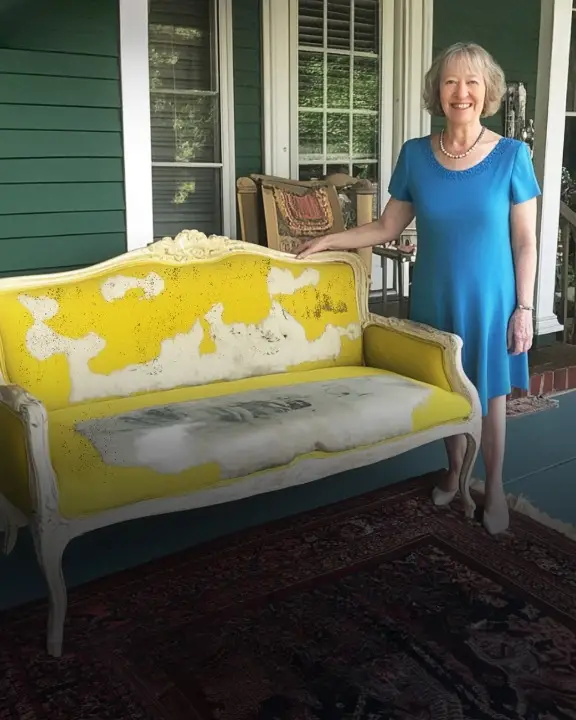I. Introduction: The Unusual Gift That Set the Stage for Transformation
In today’s world, family relationships and unexpected surprises often create an intricate tapestry of emotion and conflict. Few experiences capture these complexities as vividly as the moment when a stepmother presents a gift that is as unconventional as it is challenging. For Nicole—a young woman caught between conflicting loyalties and expectations—the day began with a phone call that hinted at a grand gesture. With excitement and cautious optimism, she rushed to her father’s house, only to discover a reality that would force her to choose between pleasing her father and asserting herself against an unwelcome gesture.
This article recounts the detailed narrative of how Nicole was “gifted” an old, smelly couch by her stepmother, Susan. More than a mere piece of furniture, this couch became the focal point of family tension, creative reinvention, and eventual success as Nicole transformed it into something new and valuable. Along the way, the tale explores themes of gratitude, defiance, compromise, and the redemptive power of hard work and ingenuity.
We begin by setting the scene in an ordinary morning full of anticipation, then move into the emotions and conflicts that arose upon the gift’s revelation. Finally, we examine the transformation process—detailing the steps Nicole took to restore the couch—and conclude with the surprising aftermath, including a contentious demand for compensation from her stepmother. The narrative is a testament to the notion that every setback contains the seed of an opportunity for reinvention if one has the courage and creativity to embrace change.
II. The Anticipation: A Call from a Stepmother
A. The Unexpected Announcement
Nicole’s day began in a manner that many might consider promising. Early that morning, her stepmother, Susan, called with an enthusiastic tone, insisting that she had a “priceless” gift waiting for Nicole. Susan’s choice of the word “priceless” was deliberate—a term meant to evoke a sense of inestimable worth and to excite the recipient with the prospect of a truly remarkable present. For Nicole, whose relationship with her stepmother had never been particularly close, the call was unexpected. In fact, given the chilly rapport that had long existed between them, she felt a mixture of apprehension and curiosity.
During the conversation, Susan explained that due to the size of the gift, she was unable to move it by herself. “You’re going to love it, Nicole! It’s absolutely priceless! Come over later today, and we’ll show it to you,” Susan had said. Despite her lingering doubts about her stepmother’s sincerity—given their history—Nicole decided to set aside any misgivings and approach the situation with cautious optimism. After all, perhaps a genuine gesture was emerging amidst years of indifference.
B. Nicole’s Mixed Emotions: Curiosity and Conflict
As Nicole set out for her father’s house, she couldn’t help but feel a tangle of emotions. Like many moments in life that force one to confront a difficult truth, the memory of Susan’s past gestures—ranging from trivial gifts such as water bottles and socks to even less thoughtful surprises—mingled with a glimmer of hope. Nicole wanted, for once, to believe that her stepmother might actually be reaching out sincerely. Yet, even as she drove away with a spark of anticipation, a part of her remained guarded, prepared for disappointment.
Inside the car, Nicole’s thoughts raced. “Curiosity killed the cat, Nic,” she mused to herself. She hoped that perhaps this time, the gift might be genuine—a break from the norm that could signify a tentative step toward a better relationship. However, an undercurrent of skepticism never fully left her mind, as she was well aware of the past patterns that had defined her interactions with Susan.
III. Arriving at Her Father’s House: The Premonition of What’s to Come
A. A Warm Welcome Dotted with Underlying Tension
Nicole arrived at her father’s house filled with expectation, yet the environment was tinged with an unspoken tension. Her father greeted her warmly, noting that Susan was busy sorting out the basement—a task that might finally represent a long-overdue cleaning out of accumulated clutter. Her father’s casual tone, as he mentioned that Susan was “sorting out her clutter,” provided little indication of what the gift might entail.
At this point, her father suggested enjoying a cup of tea, typical of their familial routine, yet Nicole’s curiosity overrode the urge to simply settle in. “No, let me check out the gift first, Dad,” she insisted with genuine eagerness. His chuckle, oblivious to the storm of conflicting emotions Nicole experienced, only amplified her anticipation. He promised to fetch Susan so that they could all sit down for tea and, perhaps, celebrate a new beginning brought on by this unusual gift.
B. The Long-Awaited Revelation
Moments later, as her father and Susan emerged from the basement, the scene that unfolded before Nicole’s eyes was nothing short of shocking. There, cradled clumsily between her father and her stepmother, was an old couch—the ugliest and smelliest piece of furniture she had ever encountered. The fabric was in disrepair; stains had become the permanent signature of years of neglect, and an overpowering odor filled the air, as if the couch itself harbored a history of decay and disregard.
Susan beamed with pride, as if bestowing upon Nicole the keys to a coveted treasure. “Happy Birthday!” she declared with unbridled enthusiasm, her smile masking the bitter truth behind her gesture. Nicole’s father, caught between hope and obligation, looked at her expectantly. But the reaction Nicole felt was a tumultuous blend of shock, revulsion, and a profound internal conflict—rejecting the gift would hurt her father, but accepting it as is would be a betrayal of her own sense of decency.
With a heavy heart and a resolute spirit, Nicole found herself caught in a quandary: Should she allow the repulsive gift to go unchallenged in order to spare her father’s feelings, or should she seize the moment to assert her independence by transforming this unsightly relic into something of real value?
IV. The Decision: Accepting the Gift and Plotting a Transformation
A. The Ultimatum of Duty Versus Defiance
In that moment, Nicole experienced a pivotal realization about the nature of her relationship with her stepmother. Susan, who had never truly embraced her as more than a bothersome presence, was now using the gift as a tool to maintain her influence over Nicole’s life. The old couch, a clear symbol of neglect and disregard, was being imposed upon her. Yet, despite her internal turmoil, Nicole resolved to accept the gift—not as a token of familial love, but as a challenge to be overcome.
Her decision was not made lightly. On one hand, rejecting the gift would undoubtedly upset her father, who still harbored a deep-seated affection for Susan. On the other, accepting it offered an opportunity: a chance to reclaim control and assert her creative agency. With a mix of determination and reluctant acceptance, Nicole vowed to transform the dilapidated couch into something extraordinary—a tangible testament to her ability to overcome the undesirable and turn it into a reward for her hard work.
B. The Catalyst: Calling in Reinforcements
Realizing that transforming the couch would be no small feat, Nicole quickly arranged for assistance. Understanding that her father’s affection for Susan complicated matters further, she discreetly called her boyfriend, Derek, for help. Derek, a steadfast partner with a keen eye for detail and a supportive spirit, agreed to lend his van and his expertise. His arrival signified not only the start of a labor-intensive project but also a turning point in how Nicole would navigate her complex familial relationships. By calling in Derek, she was taking a decisive step toward reclaiming something that was not originally hers—a way to invert the power dynamic and ultimately, profit from the transformation.
Derek’s supportive presence provided Nicole with the confidence she needed to face the task ahead. Together, they loaded the questionable couch into his van, setting the stage for a restoration project that would test Nicole’s patience, creativity, and determination. In that moment, the old, smelly couch was no longer just an unwanted gift—it represented a blank canvas for transformation and the reclamation of personal agency.
V. The Restoration Journey: Overcoming Odor, Stains, and Decay
A. Confronting the Olfactory Assault
The first and most immediate challenge was the couch’s overpowering odor. As soon as Nicole took her first whiff, she was hit by a stench that could only be described as a combination of years of neglect and sustained decay. This odor was more than just unpleasant—it was a symbol of the state in which the couch had been abandoned, a haunting reminder of the lack of care it had received over the years.
Determined not to be defeated by the smell, Nicole turned to the internet in search of a solution. Her research led her to a DIY deodorizing remedy that involved a simple yet effective combination of white vinegar, water, and a few drops of lavender essential oil. She carefully mixed these ingredients and, with a spray bottle in hand, doused the couch liberally, allowing the mixture to seep into every crevice. Though the initial burst of vinegar was pungent, Nicole patiently waited as the odor slowly dissipated, replaced by a subtler, more pleasant aroma that hinted at the promise of a refreshed future.
B. Battling the Stains: A Delicate Restoration
With the odor under control, Nicole’s next task was to tackle the unsightly stains that marred the fabric. The couch bore the scars of years of neglect: spills of unknown origin, marks from accidental scrapes, and areas where the fabric had deteriorated significantly. Armed with determination and armed with a homemade cleaning solution consisting of baking soda, hydrogen peroxide, and a touch of dish soap, Nicole set to work.
She applied the solution to the stained areas, gently scrubbing with a soft brush to work the mixture deep into the fabric fibers. For approximately fifteen minutes, she labored over each stain, watching as the deep, unsightly marks began to fade. With a damp cloth, she wiped away the solution, revealing patches of fabric that were beginning to reclaim their original color. The gradual removal of the stains bolstered her resolve; each small victory in the battle against decay was a sign that her efforts were indeed making a difference.
C. Repairing the Damage: From Rips to a Renewed Aesthetic
The physical damage to the couch extended beyond odor and stains. Years of wear had resulted in rips and tears that no amount of cleaning could mend. Nicole realized that a mere needle and thread would not suffice to restore the couch’s structural and aesthetic integrity. In a moment of conversation with Derek, who was busy preparing dinner nearby, he suggested that a “funky patch job” might be the only viable solution.
Inspired by this pragmatic approach, Nicole ventured out to her local thrift store. In the store’s eclectic aisles, she discovered a trove of materials that could serve as the building blocks for her restoration project: fabric in colors and textures that, while not identical, would complement the existing material; decorative buttons; frills that exuded charm; and even a couple of throw cushions that could be repurposed to cover larger gaps.
Returning home with her newfound supplies, Nicole set to work with meticulous care. Using fabric glue to secure the larger patches and an iron-on fabric mender for the smaller tears, she began the delicate process of repair. With each patch carefully applied and every rip mended with precision, the couch gradually transformed from a relic of neglect into an object of creative reinvention. To tie it all together, Nicole added decorative buttons and tufting in strategic areas, lending the entire piece a look that, while undeniably experimental, was also intentionally designed.
D. The Final Flourish: Steaming and Presenting the New Creation
After the laborious day of repairing and cleaning, Nicole was not yet finished. Determined to achieve a truly remarkable transformation, she decided that the final step would be to thoroughly steam clean the entire piece. The following morning, armed with her steam cleaner, she devoted hours to this final task. Methodically, she passed the steamer over every inch of the couch, ensuring that any lingering imperfections were erased and that the fabric took on a renewed, vibrant appearance.
The transformation was nothing short of extraordinary. What had once been an old, smelly, and stained couch now resembled a piece of furniture that could easily find a place in a stylish living room. The fabric had regained its luster; the color was more uniform; and, most importantly, the offensive odor had been replaced with a fresh, clean scent. In that moment, as Nicole surveyed her handiwork with a mixture of relief and satisfaction, she knew that all the hard work had been worth it.
VI. The Twist: An Unwelcome Demand After Rebirth
A. The Surprise When the Couch Gains Value
Having successfully transformed the couch into a piece worthy of admiration—and potentially, even monetary reward—Nicole decided to test the market. In a playful yet curious moment, she posted the refurbished couch on a social media marketplace, listing it with an eye-catching price that reflected the value added through her extensive restoration efforts. To her astonishment, the couch quickly attracted interest from potential buyers. Within a day, she received an offer from someone residing in an upscale area, and the offer was more than fair.
The buyer, intrigued by the story and impressed by the transformation, expressed gratitude for the couch’s new life. “This couch is going to be perfect for my art studio! Why would you ever want to get rid of it?” the buyer exclaimed during an in-person visit. For Nicole, the validation of her hard work—earning her a handsome sum from something that had once been completely undesirable—was both fulfilling and empowering.
B. The Moment of Confrontation: A Demand from the Stepmother
However, not all responses to the transformation were positive. A few days after the sale was finalized, Susan, Nicole’s stepmother, unexpectedly showed up at her doorstep. Her demeanor was one of outrage, and her eyes burned with indignation. Apparently, upon discovering that Nicole had not only accepted the “gift” of the couch but had also transformed it into a valuable commodity and sold it, Susan felt compelled to assert a claim over the profit generated.
“You ungrateful little brat! How dare you sell my gift?” Susan screamed, her voice echoing with a mix of anger and entitlement. She claimed that because the original couch had been her property—a gift originally intended to be given to Nicole for her birthday—she was entitled to half of the proceeds, amounting to $2,500. It was a demand that shocked Nicole to her core, as the idea that a crumbling, repugnant piece of furniture could suddenly become a point of contention was absurd.
Nicole, however, remained resolute. “Susan, you gave me a piece of junk. Actual junk,” she retorted. “I put in the time, the sweat, and the creativity to restore it to something of value. The profit is the result of my hard work.” With those words, Nicole drew a definitive line: if Susan wished to profit from the endeavor, she should have undertaken the restoration process herself, rather than expecting Nicole’s labor to be partially surrendered.
C. The Aftermath: Embracing Independence and Hard-Earned Reward
Susan’s angry tirade marked the climax of a long, emotionally charged day that had begun with cautious excitement and ended with hard-won success. In the days that followed, Nicole found herself reflecting on the events with mixed emotions—a blend of vindication, relief, and even a sense of empowerment. The entire experience had forced her to navigate complicated family dynamics, assert her independence in the face of condescension, and ultimately, prove that hard work and creativity could transform not only a piece of furniture but also the dynamics of familial relationships.
Nicole’s journey from dread to determination serves as a potent reminder of the transformative power of reinvention. In accepting what had initially seemed like an unwanted gift, she redefined the narrative—taking what was once an expression of control or neglect and turning it into a symbol of resilience and innovation.
VII. Reflections on Family, Gifts, and the Value of Reinvention
A. The Complexity of Stepfamily Relationships
At the heart of Nicole’s experience lies a nuanced portrait of stepfamily dynamics. For many, a stepmother’s gestures can often be fraught with mixed feelings—oscillating between the hope for genuine affection and the dread of unanticipated strings attached. In Nicole’s case, Susan’s gift, delivered with grandiose promises and a forced smile, was emblematic of a relationship that had long been defined by emotional distance and unmet expectations.
Nicole’s internal struggle—torn between her desire to honor her father’s feelings and her need to assert her own independence—captures the essence of a complex and often painful aspect of blended families. It is in these moments, when family members offer gifts that seem burdened with ulterior motives, that one must carefully balance gratitude with self-respect. Nicole’s decision to transform the couch was not just about improving a piece of furniture; it was about redefining her own sense of agency and reclaiming control over her personal narrative.
B. The Transformative Power of Creativity
The process of taking an unwanted, decrepit object and turning it into something valuable is, in many ways, a metaphor for personal growth and resilience. Nicole’s journey through the cleanup, repair, and creative restoration of the couch mirrors the universal experience of overcoming challenges and finding new purpose in unexpected places. Her experience serves as a compelling testament to the idea that one’s circumstances do not define one’s destiny—rather, it is the willingness to embrace change and invest in self-improvement that ultimately leads to success.
Every step of the restoration process—from confronting the overwhelming odor to meticulously patching fabric and adding artistic embellishments—was an act of transformation. What had once been seen as a symbol of neglect was reborn as a canvas for creativity, a tangible outcome of persistent effort and vision. This transformation allowed Nicole to assert that her worth, and the value of her contributions, far exceeded any perceived obligation that might have been imposed by her stepmother’s gesture.
C. The Importance of Self-Advocacy and Boundaries
Nicole’s eventual confrontation with Susan underscores a critical lesson about self-advocacy and the importance of setting boundaries. When confronted with a demand for a share of the profit that she had earned through her own labor, Nicole refused to yield. In doing so, she asserted that her hard work was solely her own, a product of her ingenuity and determination. This stance is emblematic of a broader principle: that one must take ownership of one’s efforts and not allow others to claim undue credit or compensation.
Her defiant response to Susan—declaring that if the stepmother wanted to profit, she should have handled the initial gift herself—resonates as a powerful affirmation of independence. It is a reminder that in relationships characterized by complexity, establishing clear boundaries is essential to preserving one’s self-respect and achieving personal growth.
VIII. Lessons Learned and Moving Forward
A. Reclaiming Control in the Face of Unwanted Gifts
Nicole’s experience with the old, smelly couch is a powerful narrative of reclaiming control over one’s circumstances. When faced with an unsolicited gift that symbolized more than just a physical object—representing instead an attempt at control—she chose to assert her autonomy. By taking the initiative to transform the couch into something that not only held aesthetic value but also promised a financial return, she demonstrated that even the most challenging situations can be turned around with creativity and effort.
This experience offers valuable lessons for anyone grappling with unwanted circumstances or difficult interpersonal dynamics. Whether in the context of family, work, or social engagements, the act of transforming an objectionable situation into an opportunity for personal enrichment is a testament to the resilience of the human spirit.
B. The Value of Hard Work and Determination
The restoration project was far from easy. It involved confronting literal and metaphorical messes—dealing with a repugnant odor, fighting against years of stains and wear, and repairing physical damage that at first seemed irreparable. Yet, each step of the process reinforced the idea that hard work and determination can overcome even the most daunting obstacles. Nicole’s experience is an inspiring example of how dedication and persistence not only restore physical objects but also rebuild self-confidence and personal worth.
Her journey from initial frustration to eventual triumph over the defective couch represents a microcosm of life’s larger challenges. It reinforces the notion that while the path to transformation may be fraught with setbacks, perseverance can lead to rewards that far surpass the initial cost. Moreover, the sense of pride and accomplishment that accompanied the successful restoration became a catalyst for further personal growth and financial opportunity.
C. Redefining Family Ties and Personal Boundaries
Central to Nicole’s story is the complex web of familial obligations, expectations, and personal boundaries. Her interactions with her stepmother, Susan, reveal the often-unspoken tensions that accompany blended family relationships. Nicole’s journey toward asserting her own values—even in the face of a gift intended to manipulate or undermine her autonomy—exemplifies the importance of standing up for oneself.
In redefining the narrative around the gift, Nicole not only transformed a physical object but also reconfigured the emotional landscape of her relationship with her stepmother. By refusing to give in to demands for a share of her hard-earned gains, she set a clear precedent: the rewards of one’s own effort belong solely to the individual who labored for them. This message is one of empowerment, urging readers to trust their instincts, embrace their creativity, and recognize that true value comes from within.
IX. Beyond the Couch: Related Stories and Broader Themes
A. When Family Gifts Turn Into Lessons in Resilience
Nicole’s experience is not an isolated incident. Across the country, many people find themselves in situations where the gifts received from loved ones come with unexpected conditions and hidden challenges. One such story involves a family who received an old, run-down house as a gift—a house that required extensive renovations. Much like Nicole’s journey with the couch, these stories often end with the recipient reclaiming control, investing effort to turn a liability into an asset, and, ultimately, learning invaluable lessons about resilience and the power of creative transformation.
In related narratives, recipients of seemingly impractical gifts have transformed dilapidated items into works of art or profitable ventures. These stories serve as a reminder that what is often dismissed as unwanted or unworthy can, with ingenuity and commitment, become a symbol of personal triumph. They underscore the transformative potential that lies dormant in every challenge, waiting only for the right moment—and the right mindset—to bring it to the surface.
B. The Complex Dynamics of Stepfamily Relationships
The intricacies of stepfamily relationships have long been explored in literature, film, and personal accounts. Nicole’s story adds another layer to this complex narrative, showcasing how a seemingly negative gesture can become a catalyst for self-assertion and growth. Stepfamily dynamics are often characterized by a blend of obligation, resentment, and occasional unexpected kindness. However, when gifts or gestures are used to assert control or foster dependency, they can backfire—prompting the recipient to seek autonomy and redefine personal boundaries.
Nicole’s transformation of the couch is emblematic of a broader principle: that acceptance does not mean submission, and that personal agency can triumph over even the most unwelcome circumstances. Her journey reflects the evolving nature of family relationships in a modern context, where personal empowerment and emotional independence are increasingly recognized as vital components of healthy interactions.
C. The Empowerment of Creative Restoration
At its core, the restoration of the old couch is a tale of creative empowerment. Transformative projects—whether renovating a home, repurposing discarded furniture, or turning a minor setback into a major success story—serve as poignant reminders of our ability to effect change. Nicole’s project is not merely about repairing a piece of furniture; it is a metaphor for personal reinvention. It encapsulates the idea that even when presented with an object that seems to carry all the marks of neglect and disrepair, one can channel creativity and hard work into producing something of genuine worth.
The DIY movement has long celebrated such transformations, and Nicole’s story dovetails with a broader cultural trend that values sustainability, resourcefulness, and the reimagining of the old into the new. Her hands-on approach, her willingness to invest both time and effort into a project initially perceived as burdensome, and her ultimate success in creating value out of what was once deemed useless—all serve as powerful lessons for anyone facing adversity.
X. Final Reflections: The Power of Choice and Transformation
In the end, Nicole’s journey—from the moment she received the unwanted gift from her stepmother to the triumphant restoration and eventual sale of the couch—is a story of transformation, resilience, and the reclamation of personal power. It forces us to confront difficult questions: How do we react when faced with something we know is flawed? Can we take what is given, however undesirable, and turn it into something meaningful and valuable? For Nicole, the answer was a resounding yes.
Her decision to accept the couch, rather than reject it outright, was not an act of submission but a calculated choice to reclaim control over a situation that was originally intended to demean and manipulate. In transforming the couch from an object of repulsion into a symbol of creativity and hard-earned success, Nicole not only redefined the value of a physical item but also the dynamic of a deeply complicated family relationship.
Her story stands as an important reminder that every challenge presents an opportunity for growth. It is an invitation to trust your instincts, work diligently to overcome obstacles, and, ultimately, create something that reflects your own unique vision and worth. As we consider the lessons from Nicole’s experience, we are reminded that true empowerment lies in our ability to reshape our narratives—turning every “gift” into a stepping stone toward a better, more self-determined future.
For anyone who has ever found themselves doubting whether an unwanted burden can lead to positive change, Nicole’s tale is a powerful affirmation. In a world where unexpected challenges abound, it is our creative spirit and unwavering determination that ultimately allow us to thrive in the face of adversity.
XI. Conclusion: Embracing the Journey of Reinvention
Nicole’s experience with the old, smelly couch is more than just a quirky anecdote about a problematic birthday gift—it is a vivid illustration of what can happen when you dare to turn an unfavorable situation into an opportunity for personal reinvention. The narrative we have explored in this report details a journey marked by initial shock, internal conflict, and a gradual, determined progression toward transformation. Throughout the entire process, Nicole was faced with a choice that many of us confront at various moments in life: either succumb to the negativity of the situation or harness it as fuel for creativity and progress.
By choosing to accept and then meticulously restore the couch, Nicole managed to assert her independence in the face of familial pressure and reclaim a sense of control over her destiny. Her journey serves as a reminder that even when gifted something that appears to be nothing more than an unwanted burden, we possess the power to transform it into a symbol of our own resilience and ingenuity.
This story also carries broader implications for how we approach challenges in general—whether they come in the form of problematic gifts, difficult relationships, or unexpected setbacks in life. It underscores the idea that transformation is not merely a matter of external repair but an internal process of empowerment. Nicole’s willingness to take ownership of the situation, to innovate and to push through the initial revulsion, stands as a testament to the enduring human capacity to reinvent and improve.
For those who find themselves confronted with obstacles that seem insurmountable, Nicole’s example offers both inspiration and pragmatic advice. Embrace the unexpected, use it as a catalyst for change, and remember that true value is often created through the process of hard work, creativity, and unwavering determination.
As you reflect on this narrative and the lessons it imparts, consider how you might apply similar principles in your own life. Whether it is dealing with an unsavory gift, overcoming a personal setback, or navigating complicated relationships, remember that every challenge offers the potential for reinvention. The journey to transformation may be long and fraught with difficulties, but the rewards—both tangible and intangible—can be profoundly liberating.
In closing, Nicole’s account of turning a repugnant, neglected couch into a piece of art and a source of financial reward is not just a story about furniture restoration—it is a celebration of human resilience. It reminds us that every obstacle can be reimagined as an opportunity for growth, that every negative situation holds the potential to be transformed into something meaningful, and that through creativity and perseverance, we can redefine our lives on our own terms.






